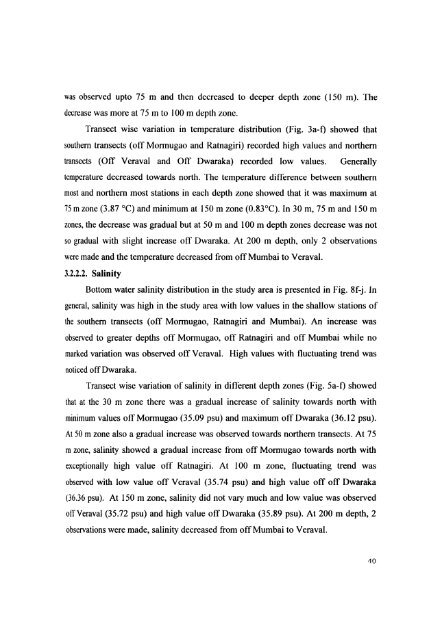L - Cochin University of Science and Technology
L - Cochin University of Science and Technology
L - Cochin University of Science and Technology
Create successful ePaper yourself
Turn your PDF publications into a flip-book with our unique Google optimized e-Paper software.
was observed upto 75 m <strong>and</strong> then decreased to deeper depth zone (150 m). The<br />
decrease was more at 75 m to 100 m depth zone.<br />
Transect wise variation in temperature distribution (Fig. 3a-t) showed that<br />
southern transects (<strong>of</strong>f Mormugao <strong>and</strong> Ratnagiri) recorded high values <strong>and</strong> northern<br />
transects (OfT Veraval <strong>and</strong> Off Dwaraka) recorded low values. Generally<br />
temperature decreased towards north. The temperature difference between southern<br />
most <strong>and</strong> northern most stations in each depth zone showed that it was maximum at<br />
75 m zone (3.87 QC) <strong>and</strong> minimum at 150 m zone (0.83 Q C). In 30 m, 75 m <strong>and</strong> 150 m<br />
zones, the decrease was gradual but at 50 m <strong>and</strong> 100 m depth zones decrease was not<br />
so gradual with slight increase <strong>of</strong>f Dwaraka. At 200 m depth, only 2 observations<br />
were made <strong>and</strong> the temperature decreased from <strong>of</strong>f Mumbai to Veraval.<br />
3.2.2.2. Salinity<br />
Bottom water salinity distribution in the study area is presented in Fig. 8f-j. In<br />
general, salinity was high in the study area with low values in the shallow stations <strong>of</strong><br />
the southern transects (<strong>of</strong>f Mormugao, Ratnagiri <strong>and</strong> Mumbai). An increase was<br />
observed to greater depths <strong>of</strong>f Mormugao, <strong>of</strong>f Ratnagiri <strong>and</strong> <strong>of</strong>T Mumbai while no<br />
marked variation was observed <strong>of</strong>T Veraval. High values with fluctuating trend was<br />
noticed <strong>of</strong>f Dwaraka.<br />
Transect wise variation <strong>of</strong> salinity in difTerent depth zones (Fig. 5a-t) showed<br />
that at the 30 m zone there was a gradual increase <strong>of</strong> salinity towards north with<br />
minimum values <strong>of</strong>T Mormugao (35.09 psu) <strong>and</strong> maximum <strong>of</strong>f Dwaraka (36.12 psu).<br />
At 50 m zone also a gradual increase was observed towards northern transects. At 75<br />
m zone, salinity showed a gradual increase from <strong>of</strong>T Mormugao towards north with<br />
exceptionally high value otT Ratnagiri. At 100 m zone, fluctuating trend was<br />
observed with low value <strong>of</strong>T Veraval (35.74 psu) <strong>and</strong> high value <strong>of</strong>T <strong>of</strong>T Dwaraka<br />
(36.36 psu). At 150 m zone, salinity did not vary much <strong>and</strong> low value was observed<br />
otTVeraval (35.72 psu) <strong>and</strong> high value <strong>of</strong>T Dwaraka (35.89 psu). At 200 m depth, 2<br />
observations were made, salinity decreased from <strong>of</strong>fMumbai to Veraval.<br />
40

















